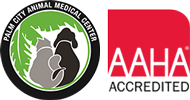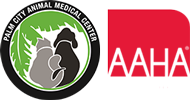Modern convention tells us we should brush our teeth twice a day and visit our dentist twice a year, but have you ever wondered about your pet’s oral health? Can you imagine how your teeth and gums would look—and smell—if you went months or years without brushing and flossing? Your pet’s dental health is as important as yours, and because your four-legged family members can’t report which tooth hurts, prevention and regular check-ups are vital.
Relaxed, or absent, dental care has the same result, whether the patient has two legs or four: periodontal disease. Because most pet owners don’t think twice about their pet’s teeth and gums, 85% of dogs and cats over the age of 3 years have periodontal disease. Depending on your pet’s breed and species, he could be looking at 15 or more years of dental disease and pain.
Periodontal disease in pets
Periodontal disease is the most common medical condition that small animal veterinary professionals see, and occurs when plaque is allowed to build up on the tooth, both above and below the gumline. Bacteria in plaque mix with mineral salts in your pet’s food to produce tartar, the hard, brown build-up found on the teeth near the gumline.
Bacteria in the tartar produce toxins that irritate the gums and cause gingivitis, which is the first sign of periodontal disease. Normal gum tissue is pink, and should have a smooth, thin, knife-like edge where the tissue meets the tooth. When gingivitis is present, the gums will bleed easily, so if your pet’s gums bleed after you brush his teeth, or after he chews on rough or hard toys, pay attention, because he may have gingivitis.
As gingivitis progresses, your pet’s gums will become reddened and thick, and halitosis (i.e., bad breath) won’t be far behind. Halitosis is often an owner’s first complaint and should not be present unless your pet has ingested something stinky. Rather, halitosis is almost always the result of periodontal disease, so your pet needs a dental exam if he has bad breath.
In addition to causing gingivitis, bacteria below the gumline affect the tissues surrounding the tooth roots, leading to bone loss, periodontal ligament destruction, loosening of the teeth, and eventual tooth loss.
Consequences of periodontal disease in pets
Periodontal disease that is allowed to progress will cause not only tooth loss, but also local (i.e., dental) and systemic (i.e., whole body) problems.
Local consequences can include:
- Oro-nasal fistula
- Tooth root abscess
- Pathologic jaw fracture
- Osteomyelitis (i.e., the presence of dead, infected bone)
Systemic consequences can include:
- Decreased liver and kidney function
- Increased insulin resistance
- Exacerbation of some cardiac conditions
At-home preventive dental care for pets
Gingivitis is the only reversible stage of dental disease. The changes that occur once periodontal disease has affected the underlying tissues surrounding the teeth are permanent, so tackling dental disease head-on is imperative. When you look in the mirror, you won’t see a thick, brown tartar buildup on your teeth, because twice a day, you remove plaque when you brush your teeth. Removing plaque before it transforms into calculus will prevent periodontal disease in your pet.
Daily tooth brushing is the gold standard of home dental care for your pet. Set aside some time each day to brush your pet’s teeth—you should set a calendar reminder for every day until it becomes routine. There are many toothbrush options for pets, including veterinary toothbrushes with long handles and angled heads, but owners sometimes find that a finger brush, which is a plastic, bristled cap they place on their index finger, gives them greater control in their pet’s mouth. Always use a toothpaste made specifically for dogs and/or cats, which typically is available in pet-friendly flavors, like chicken or fish.
Veterinary dental procedures for pets

You brush your teeth twice a day, but you still visit your dentist for a thorough exam and cleaning twice a year. Likewise, you may be diligently brushing your pet’s teeth at home, but we may still recommend a professional cleaning. That doesn’t mean you’re doing a bad job of maintaining your pet’s dental health—it simply means your pet’s mouth needs a little extra attention.
On the day of your pet’s dental procedure, you must not feed him breakfast, because our veterinary team will anesthetize him for the procedure, since he won’t open wide willingly, and his stomach must be empty. Once he is under anesthesia, we will examine each tooth and measure each periodontal pocket, and radiograph the tooth roots to ensure his mouth is healthy.
A diseased tooth that cannot be salvaged may need extraction. In that case, rest assured that we will use intraoperative pain control and will also send your pet home with medication for post-operative pain.
Many owners report that their pets have an extra pep in their step after their dental issues and periodontal disease are treated, and that they act more like puppies and kittens when they no longer suffer with chronic pain. A healthy mouth can improve your pet’s quality of life, and perhaps also give him a longer life. If it’s been a while since we’ve examined your pet for dental issues, or if his breath makes your eyes water, give us a call to schedule an exam.








Leave A Comment